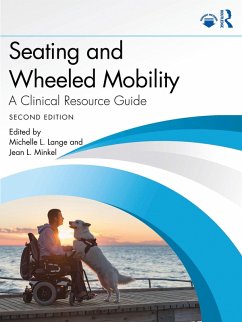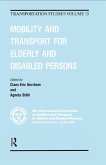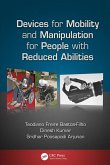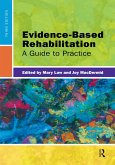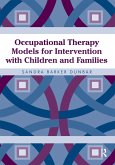Seating and Wheeled Mobility (eBook, PDF)
A Clinical Resource Guide
Redaktion: Lange, Michelle L.; Minkel, Jean L.
84,95 €
84,95 €
inkl. MwSt.
Sofort per Download lieferbar

42 °P sammeln
84,95 €
Als Download kaufen

84,95 €
inkl. MwSt.
Sofort per Download lieferbar

42 °P sammeln
Jetzt verschenken
Alle Infos zum eBook verschenken
84,95 €
inkl. MwSt.
Sofort per Download lieferbar
Alle Infos zum eBook verschenken

42 °P sammeln
Seating and Wheeled Mobility (eBook, PDF)
A Clinical Resource Guide
Redaktion: Lange, Michelle L.; Minkel, Jean L.
- Format: PDF
- Merkliste
- Auf die Merkliste
- Bewerten Bewerten
- Teilen
- Produkt teilen
- Produkterinnerung
- Produkterinnerung

Bitte loggen Sie sich zunächst in Ihr Kundenkonto ein oder registrieren Sie sich bei
bücher.de, um das eBook-Abo tolino select nutzen zu können.
Hier können Sie sich einloggen
Hier können Sie sich einloggen
Sie sind bereits eingeloggt. Klicken Sie auf 2. tolino select Abo, um fortzufahren.

Bitte loggen Sie sich zunächst in Ihr Kundenkonto ein oder registrieren Sie sich bei bücher.de, um das eBook-Abo tolino select nutzen zu können.
Fully revised and updated in its second edition, this book presents clinical assessment considerations when working with a person with a disability who may need wheelchair seating for postural support and to protect skin integrity, or a wheelchair base to best meet dependent or independent mobility needs.
- Geräte: PC
- mit Kopierschutz
- eBook Hilfe
Andere Kunden interessierten sich auch für
![Mobility and Transport for Elderly and Disabled Patients (eBook, PDF) Mobility and Transport for Elderly and Disabled Patients (eBook, PDF)]() Claes-Eric NorrbomMobility and Transport for Elderly and Disabled Patients (eBook, PDF)493,95 €
Claes-Eric NorrbomMobility and Transport for Elderly and Disabled Patients (eBook, PDF)493,95 €![Devices for Mobility and Manipulation for People with Reduced Abilities (eBook, PDF) Devices for Mobility and Manipulation for People with Reduced Abilities (eBook, PDF)]() Teodiano Bastos-FilhoDevices for Mobility and Manipulation for People with Reduced Abilities (eBook, PDF)85,95 €
Teodiano Bastos-FilhoDevices for Mobility and Manipulation for People with Reduced Abilities (eBook, PDF)85,95 €![Evidence-Based Rehabilitation (eBook, PDF) Evidence-Based Rehabilitation (eBook, PDF)]() Mary LawEvidence-Based Rehabilitation (eBook, PDF)68,95 €
Mary LawEvidence-Based Rehabilitation (eBook, PDF)68,95 €![Journal Article Writing and Publication (eBook, PDF) Journal Article Writing and Publication (eBook, PDF)]() Sharon A. GutmanJournal Article Writing and Publication (eBook, PDF)29,95 €
Sharon A. GutmanJournal Article Writing and Publication (eBook, PDF)29,95 €![Occupational Therapy Models for Intervention with Children and Families (eBook, PDF) Occupational Therapy Models for Intervention with Children and Families (eBook, PDF)]() Sandra DunbarOccupational Therapy Models for Intervention with Children and Families (eBook, PDF)85,95 €
Sandra DunbarOccupational Therapy Models for Intervention with Children and Families (eBook, PDF)85,95 €![An Evidence-Based Guide to Combining Interventions with Sensory Integration in Pediatric Practice (eBook, PDF) An Evidence-Based Guide to Combining Interventions with Sensory Integration in Pediatric Practice (eBook, PDF)]() An Evidence-Based Guide to Combining Interventions with Sensory Integration in Pediatric Practice (eBook, PDF)36,95 €
An Evidence-Based Guide to Combining Interventions with Sensory Integration in Pediatric Practice (eBook, PDF)36,95 €![Health Services (eBook, PDF) Health Services (eBook, PDF)]() Robert W. SandstromHealth Services (eBook, PDF)37,95 €
Robert W. SandstromHealth Services (eBook, PDF)37,95 €-
-
-
Fully revised and updated in its second edition, this book presents clinical assessment considerations when working with a person with a disability who may need wheelchair seating for postural support and to protect skin integrity, or a wheelchair base to best meet dependent or independent mobility needs.
Dieser Download kann aus rechtlichen Gründen nur mit Rechnungsadresse in A, B, BG, CY, CZ, D, DK, EW, E, FIN, F, GR, HR, H, IRL, I, LT, L, LR, M, NL, PL, P, R, S, SLO, SK ausgeliefert werden.
Produktdetails
- Produktdetails
- Verlag: Taylor & Francis eBooks
- Seitenzahl: 774
- Erscheinungstermin: 30. Dezember 2024
- Englisch
- ISBN-13: 9781040262016
- Artikelnr.: 72536808
- Verlag: Taylor & Francis eBooks
- Seitenzahl: 774
- Erscheinungstermin: 30. Dezember 2024
- Englisch
- ISBN-13: 9781040262016
- Artikelnr.: 72536808
- Herstellerkennzeichnung Die Herstellerinformationen sind derzeit nicht verfügbar.
Michelle L. Lange is an occupational therapist with over 38 years of experience and has been in private practice, Access to Independence, for over 19 years. She is a well-respected lecturer, both nationally and internationally, and has authored numerous texts, chapters, and articles. She is the former NRRTS Continuing Education Curriculum Coordinator and Clinical Editor of NRRTS Directions magazine. Michelle is a RESNA Fellow and member of the Clinician Task Force. She is a RESNA certified ATP and SMS. Jean L. Minkel is a physical therapist and compassionate clinician well recognized for her work in Assistive Technology. Jean has a passion for insuring that people with a mobility disability have access to the products and services needed to support full participation in life. Jean is the Senior Vice President of Rehab and Mobility Services for Independence Care System. She leads On A Roll, an OT/PT private practice specializing in Seating and Wheeled Mobility services. Jean is also an independent consultant who provides educational and consulting service to all members of the A.T. team. Jean has been recognized for her expertise by being named a RESNA Fellow and awarded the Sam McFarland Mentor Award.
Introduction; Section I Postural Support and Pressure Management:
Foundational Information 1 Seating and Mobility Evaluations for Persons
with Long-Term Disabilities: Focusing on the Client Assessment; 2 Pressure
Management for the Seated Client; 3 Seating System Categories and Clinical
Indicators; Section II Postural Support and Pressure Management Clinical
Applications 4 24-7 Postural Care Management; 5 Postural Support and
Pressure Management Considerations for Hands-Free Sitters; 6 Postural
Support and Pressure Management Considerations for Hands-Dependent Sitters;
7 Postural Support and Pressure Management Considerations for Prop Sitters;
8 General Positioning Strategies and Seating Interventions by Body
Location; 9 Standardized Measures of the Person, Seating System, and
Wheelchair; Section III Wheeled Mobility: Foundational Information 10 The
Mobility Algorithm: Clinical Decision-Making for a Mobility Device; 11
Manual (Self-Initiated) Mobility Categories and Clinical Indicators; 12
Power Mobility Categories and Clinical Indicators; 13 Dependent Mobility
Categories and Clinical Indicators; Section IV Wheeled Mobility: Clinical
Applications 14 Optimally Configuring Manual Wheelchairs for
Self-Propulsion; 15 Power Assist Devices and Other Alternative Drive
Mechanisms for Manual Wheelchairs; 16 Power Mobility Assessment:
Determining Readiness and Providing ON Time Mobility; 17 Power Seat
Functions: Putting Evidence into Practice; 18 Power Mobility: Optimizing
Driving; 19 Power Mobility: Driving Methods; 20 Power Mobility: Advanced
Features and Applications; 21 Training Manual and Power Wheelchair Mobility
and Maintenance Skills; Section V Putting It Together: Specialty
Applications 22 Considerations When Working with the Pediatric Population;
23 Considerations When Working with the Geriatric Population; 24
Considerations When Working with the Bariatric Population; 25
Considerations When Working with Degenerative Neurological Conditions; 26
Considerations When Working with Complex Neurological and Orthopedic
Presentations; Section VI Related Content 27 Considerations When Working
with a Person Who Is Aging with a Disability; 28 Environmental Assessment;
29 Wheelchairs and Transportation; 30 What Are Standards for Wheelchairs
and Wheelchair Seating?; 31 Documentation of the Seating and Mobility
Assessment; 32 Measuring Seating and Wheeled Mobility Outcomes; 33 Complex
Rehab Technology in North America - Past, Present, and Future Perspectives
Foundational Information 1 Seating and Mobility Evaluations for Persons
with Long-Term Disabilities: Focusing on the Client Assessment; 2 Pressure
Management for the Seated Client; 3 Seating System Categories and Clinical
Indicators; Section II Postural Support and Pressure Management Clinical
Applications 4 24-7 Postural Care Management; 5 Postural Support and
Pressure Management Considerations for Hands-Free Sitters; 6 Postural
Support and Pressure Management Considerations for Hands-Dependent Sitters;
7 Postural Support and Pressure Management Considerations for Prop Sitters;
8 General Positioning Strategies and Seating Interventions by Body
Location; 9 Standardized Measures of the Person, Seating System, and
Wheelchair; Section III Wheeled Mobility: Foundational Information 10 The
Mobility Algorithm: Clinical Decision-Making for a Mobility Device; 11
Manual (Self-Initiated) Mobility Categories and Clinical Indicators; 12
Power Mobility Categories and Clinical Indicators; 13 Dependent Mobility
Categories and Clinical Indicators; Section IV Wheeled Mobility: Clinical
Applications 14 Optimally Configuring Manual Wheelchairs for
Self-Propulsion; 15 Power Assist Devices and Other Alternative Drive
Mechanisms for Manual Wheelchairs; 16 Power Mobility Assessment:
Determining Readiness and Providing ON Time Mobility; 17 Power Seat
Functions: Putting Evidence into Practice; 18 Power Mobility: Optimizing
Driving; 19 Power Mobility: Driving Methods; 20 Power Mobility: Advanced
Features and Applications; 21 Training Manual and Power Wheelchair Mobility
and Maintenance Skills; Section V Putting It Together: Specialty
Applications 22 Considerations When Working with the Pediatric Population;
23 Considerations When Working with the Geriatric Population; 24
Considerations When Working with the Bariatric Population; 25
Considerations When Working with Degenerative Neurological Conditions; 26
Considerations When Working with Complex Neurological and Orthopedic
Presentations; Section VI Related Content 27 Considerations When Working
with a Person Who Is Aging with a Disability; 28 Environmental Assessment;
29 Wheelchairs and Transportation; 30 What Are Standards for Wheelchairs
and Wheelchair Seating?; 31 Documentation of the Seating and Mobility
Assessment; 32 Measuring Seating and Wheeled Mobility Outcomes; 33 Complex
Rehab Technology in North America - Past, Present, and Future Perspectives
Introduction; Section I Postural Support and Pressure Management:
Foundational Information 1 Seating and Mobility Evaluations for Persons
with Long-Term Disabilities: Focusing on the Client Assessment; 2 Pressure
Management for the Seated Client; 3 Seating System Categories and Clinical
Indicators; Section II Postural Support and Pressure Management Clinical
Applications 4 24-7 Postural Care Management; 5 Postural Support and
Pressure Management Considerations for Hands-Free Sitters; 6 Postural
Support and Pressure Management Considerations for Hands-Dependent Sitters;
7 Postural Support and Pressure Management Considerations for Prop Sitters;
8 General Positioning Strategies and Seating Interventions by Body
Location; 9 Standardized Measures of the Person, Seating System, and
Wheelchair; Section III Wheeled Mobility: Foundational Information 10 The
Mobility Algorithm: Clinical Decision-Making for a Mobility Device; 11
Manual (Self-Initiated) Mobility Categories and Clinical Indicators; 12
Power Mobility Categories and Clinical Indicators; 13 Dependent Mobility
Categories and Clinical Indicators; Section IV Wheeled Mobility: Clinical
Applications 14 Optimally Configuring Manual Wheelchairs for
Self-Propulsion; 15 Power Assist Devices and Other Alternative Drive
Mechanisms for Manual Wheelchairs; 16 Power Mobility Assessment:
Determining Readiness and Providing ON Time Mobility; 17 Power Seat
Functions: Putting Evidence into Practice; 18 Power Mobility: Optimizing
Driving; 19 Power Mobility: Driving Methods; 20 Power Mobility: Advanced
Features and Applications; 21 Training Manual and Power Wheelchair Mobility
and Maintenance Skills; Section V Putting It Together: Specialty
Applications 22 Considerations When Working with the Pediatric Population;
23 Considerations When Working with the Geriatric Population; 24
Considerations When Working with the Bariatric Population; 25
Considerations When Working with Degenerative Neurological Conditions; 26
Considerations When Working with Complex Neurological and Orthopedic
Presentations; Section VI Related Content 27 Considerations When Working
with a Person Who Is Aging with a Disability; 28 Environmental Assessment;
29 Wheelchairs and Transportation; 30 What Are Standards for Wheelchairs
and Wheelchair Seating?; 31 Documentation of the Seating and Mobility
Assessment; 32 Measuring Seating and Wheeled Mobility Outcomes; 33 Complex
Rehab Technology in North America - Past, Present, and Future Perspectives
Foundational Information 1 Seating and Mobility Evaluations for Persons
with Long-Term Disabilities: Focusing on the Client Assessment; 2 Pressure
Management for the Seated Client; 3 Seating System Categories and Clinical
Indicators; Section II Postural Support and Pressure Management Clinical
Applications 4 24-7 Postural Care Management; 5 Postural Support and
Pressure Management Considerations for Hands-Free Sitters; 6 Postural
Support and Pressure Management Considerations for Hands-Dependent Sitters;
7 Postural Support and Pressure Management Considerations for Prop Sitters;
8 General Positioning Strategies and Seating Interventions by Body
Location; 9 Standardized Measures of the Person, Seating System, and
Wheelchair; Section III Wheeled Mobility: Foundational Information 10 The
Mobility Algorithm: Clinical Decision-Making for a Mobility Device; 11
Manual (Self-Initiated) Mobility Categories and Clinical Indicators; 12
Power Mobility Categories and Clinical Indicators; 13 Dependent Mobility
Categories and Clinical Indicators; Section IV Wheeled Mobility: Clinical
Applications 14 Optimally Configuring Manual Wheelchairs for
Self-Propulsion; 15 Power Assist Devices and Other Alternative Drive
Mechanisms for Manual Wheelchairs; 16 Power Mobility Assessment:
Determining Readiness and Providing ON Time Mobility; 17 Power Seat
Functions: Putting Evidence into Practice; 18 Power Mobility: Optimizing
Driving; 19 Power Mobility: Driving Methods; 20 Power Mobility: Advanced
Features and Applications; 21 Training Manual and Power Wheelchair Mobility
and Maintenance Skills; Section V Putting It Together: Specialty
Applications 22 Considerations When Working with the Pediatric Population;
23 Considerations When Working with the Geriatric Population; 24
Considerations When Working with the Bariatric Population; 25
Considerations When Working with Degenerative Neurological Conditions; 26
Considerations When Working with Complex Neurological and Orthopedic
Presentations; Section VI Related Content 27 Considerations When Working
with a Person Who Is Aging with a Disability; 28 Environmental Assessment;
29 Wheelchairs and Transportation; 30 What Are Standards for Wheelchairs
and Wheelchair Seating?; 31 Documentation of the Seating and Mobility
Assessment; 32 Measuring Seating and Wheeled Mobility Outcomes; 33 Complex
Rehab Technology in North America - Past, Present, and Future Perspectives
